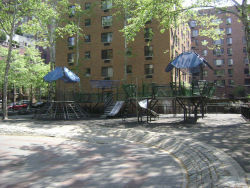Playground Eighty Nine LXXXIX
Playground 89
Playground 89 is named for its location on 89th Street, between Amsterdam and Columbus Avenues. The numbered street naming system in Manhattan is the result of the Commissioners Plan of 1811. New York City Mayor DeWitt Clinton (1769-1828) created the commission, which was charged with planning the orderly development of Manhattan north of Houston Street. Prominent New Yorkers such as politician Gouverneur Morris (1752-1816), surveyor Simeon De Witt (1756-1834), and lawyer John Rutherford (1760-1840) filled the commission’s ranks. Planners agreed on an orderly, easily accessible system of rectangular blocks to tame the unsettled land. Known as the “grid system,” the plan arranged 12 north-south avenues running perpendicular to 155 east-west cross streets, with avenues 100 feet wide and streets lying 200 feet apart. The plan also provided for parks to be located on 53rd, 66th, 77th, and 120th Streets. Latter additions to the plan included the creation of Union, Tompkins, Stuyvesant, and Madison Squares, as well as Lexington and Madison Avenues. In retrospect, the Commissioners Plan of 1811 astutely predicted and made possible huge residential growth on Manhattan during the 19th and 20th centuries.
A proposition to build a playground on this site for adjoining P.S. 166 was passed by the Board of Estimate in June 1962, at the suggestion of the Parent’s Association and several civic organizations. Originally named P.S. 166 Playground and designed by M. Paul Friedberg and Associates, the parkland was built in 1967 with an amphitheater, a wading pool with water jets, stone pyramids with slides, tree houses, a public restroom, and a climbing structure with tire swings. The original design also included the arch and gate that still stand at the entrance to the playground from the school. The playground was typical of post-war design, which incorporated popular child psychology of the time, particularly a strong belief in experiential learning and modernist architecture to create interactive play spaces with “adventure” themes. A few years after the playground’s opening, however, the innovative design was deemed too dangerous for unsupervised use, and the site was fenced in and limited to use by P.S. 166 at the behest of Parks. On March 24, 1986, Parks renamed this property Playground 89. Over the years, neighborhood residents complained that the general public could not use the park. In 1995, plans were made for the playground to be demolished and rebuilt in compliance with contemporary safety standards.
Preservationists favored retaining the old playground, but it could not meet safety standards. Landmarks West, a civic organization, worked with school officials and other volunteers to preserve the spirit of the old “adventure” playground. The Vincent Astor Foundation provided a grant to hire the playground’s original designer, M. Friedberg, to design the current playground with a new generation of play equipment. In 1999, Council Member Ronnie M. Eldridge funded a $1 million renovation to the site, in which a semi-circular amphitheater was built with water spouts at the entrance to the playground. New plantings, play equipment with safety surfacing, and fencing were also included in the new, more safety-conscious playground designed in the spirit of the original.
Check out your park's Vital Signs
Clean & Safe
Green & Resilient
Empowered & Engaged Users
Share your feedback or learn more about how this park is part of a
Vital Park System



